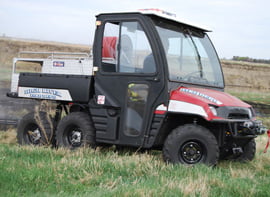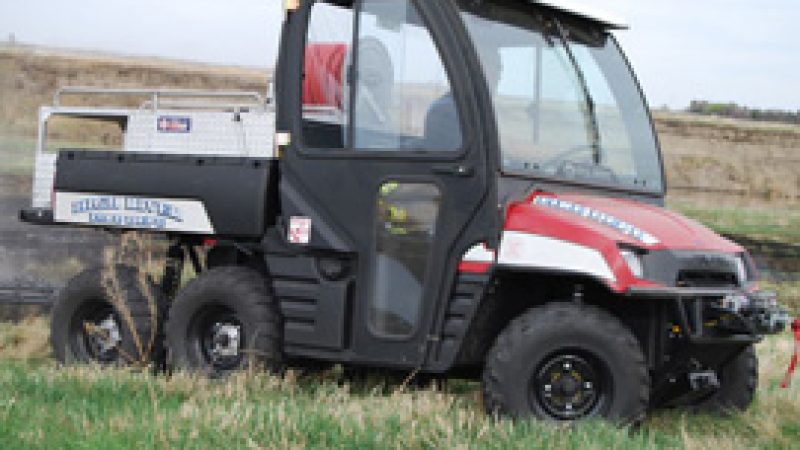In recent years, the big brother of ATV’s, known as the UTV, have seen a rapid rise in use by emergency services organizations across the country. Fire, Police and EMS are now recognizing a wide variety of uses and applications for these UTV vehicles including wildland firefighting, emergency medical evacuation from remote locations, police search and rescue operations, crowd control, SARS urban interface just to name a few.
As President and owner of one of the leading manufacturers of medical and fire skid units built specifically for these specialized vehicles, I get calls daily from chief officers and administrators from across the country inquiring about the suitability of one type of make model UTV over another. The ones that haven’t purchased a UTV yet are in luck. It is the organization that has already purchased a UTV with the mistaken notion that the particular make/model they purchased will be adequate for the needs of the emergency services they lead who are sometimes in trouble.
There are many UTV makes and models to choose from on the market today. Some are much better suited for emergency services work than others. Some UTV’s have no business being utilized by these organizations at all for emergency services work. The Polaris Ranger 6×6 and 4×4, Kubota RTV 900, Kawasaki Mule 3010, John Deere Gator 6×6 and 4×4, Cub Cadet big country, the Buffalo 6×6 and the Argo amphibious are all units that are very popular and seem to be the best suited for emergency services work. There are many other makes and models that deserve tighter scrutiny to insure they will be useful for the mission they will be expected to fulfill.
Emergency services organizations need to put just as much time, effort, thought and due diligence into the purchase of their UTV as they would for their next ambulance or fire truck. First, we need to outline mission objectives, types of typography/geography in the main response area (hilly, steep versus swampy, moist environments) and ultimately the primary mission of the UTV in the organization, medical transport, wild land firefighting or a combination of the two. Once these questions have been answered, then the organization can look at the specifications of the different type UTV models available that best meet the mission objectives. Second, safety must always be high on the list. Most UTV’s provide seat belts but make sure the UTV model you are interested in comes equipped with them (and then write proper SOG’s or SOP’s to insure your organization follows the seat belts always rule) as well as having ROPS (roll over protection structure) which is essentially a roll cage that protects the occupants of the seated areas in the UTV. Third, is the overall weight carrying capacity of the entire unit but more specific the carrying capacity of the cargo bed is of utmost importance. This is where many departments get tripped up. They go out and purchase a unit that cannot meet industry-carrying requirements of these skid units but find out too late.

When considering the purchase of a UTV, I am certain that true 4×4 or 6×6 drive train capability is a must for your organization. Again, check the make/model specifications carefully. Some claim to be 6×6 (which they are, almost) but looking closer you will find that only 4 of the 6 wheels on the vehicle are really true drive wheels. The other two wheels are just freewheeling. Test drive the units while looking at turning radius on the 6×6 versus the 4×4, or is the payload requirements of your mission dictates the 6×6 over the 4×4.
On cargo bed requirements for a medical type skid unit, I have a rule of thumb that the UTV you are buying should be rated to carry at least 650 lbs. in the cargo bed of the unit. We get to this number by adding the weight of the base skid unit (usually 150 lbs. or less) by the average weight of an attendant, patient, trauma bag, O2 bag and bottle and other necessary items. There are UTV’s out there that are rated to only carry 400 lbs. in the cargo bed, which is way below the 650 lbs. mentioned above. If it is a wild land firefighting skid with water and gear that you are interested in, that number can jump to 900 lbs. and above for a required rated cargo capacity. When doing your due diligence and getting specifications, the web sites of all the manufactures mentioned above is a great starting place. For instance, the Polaris 6×6 Ranger has an overall rated vehicle payload capacity of 1750 lbs. with a rated cargo bed capacity of 1250 lbs. The Kubota RTV 900 has similar ratings at an overall payload capacity of 1653 lbs. and 1102-lbs. cargo bed capacity. The Polaris Ranger 4×4 has a vehicle payload capacity of 1500 lbs. and a cargo bed rated capacity of 1000 lbs. As you can see, the relationship between the make and models specifications and rated capacities soon helps you narrow your search for the right UTV for the mission you expect it to undertake. Most UTV skid manufactures are starting to standardize the size of the skid units. The cargo bed of the UTV should be at least 49″ wide and 54″ long. UTV units with smaller sized beds will potentially restrict you as to how many skid units you have to choose from and could drive the price up substantially if a customized skid unit needs to be built to fit your particular UTV.
Remember, as a chief officer of an emergency services organization, you do not want to be put in the unenviable position of having to answer tough questions by a high priced litigation attorney seeing your organization because you placed the wrong UTV into the wrong mission area resulting in an accident. We must give these vehicles the same respect and due diligence when deciding which unit to purchase as we do when we buy the larger vehicles. These vehicles can harm our personnel and our patients just like if we have an accident with the larger units. It is imperative that we do everything to prevent an accident by purchasing the right UTV for the mission.
In closing, the point of this article is to get you to consider your options of makes/models of UTV’s very closely before you make the final purchase. I also want to say that I am not a fan of the use of ATV’s in use by emergency services. I bought one for my small rural department but soon felt that the unit did not provide enough safety protection for my firefighters/EMT’s. First you ride up on an ATV like on a motorcycle instead of inside a UTV like a car. Second, there are no seat belts on ATV’s where there is almost always seat belts on UTV’s, and finally the ATV can be very unstable in many conditions. ATV’s should serve limited mission roles in emergency services organizations. Remember that cheaper in terms of cost is not always best when it comes to our national motto for firefighters “Everyone comes home”.
Kimball W. Johnson is President of KIMTEK Corporation makers of the MEDLITE® Medical Transport skid unit (patent pending) and The FIRELITE® Transport for wild land firefighting. Mr. Johnson is also a volunteer Fire Chief and volunteer EMT.





